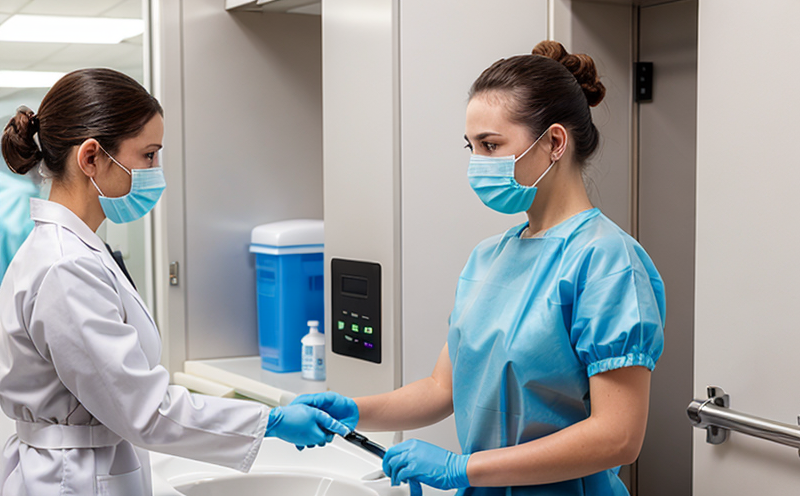ASTM E2149 Determining antimicrobial activity of immobilized agents under dynamic conditions
The ASTM E2149 standard provides a method to determine the antimicrobial efficacy of immobilized agents, such as coatings or impregnated fabrics. This testing ensures that materials maintain their antimicrobial properties in real-world use scenarios by simulating dynamic environmental conditions.
Dynamic conditions are crucial for evaluating the performance of antimicrobial treatments because they mimic the actual exposure and environmental factors encountered during product usage. Factors like humidity, temperature, and mechanical stress can significantly impact the effectiveness of an immobilized agent over time.
The test setup involves placing the specimen in a specially designed chamber where controlled parameters such as moisture content, temperature, and relative humidity are maintained. Specimens may include fabrics, coatings, or any other material that is intended to be used in an antimicrobial capacity. The microbial challenge agents (test organisms) are introduced into this environment under dynamic conditions.
The standard specifies the use of specific microbial strains such as Escherichia coli and Saccharomyces cerevisiae. These strains are chosen for their widespread use in antimicrobial testing due to their relevance across various industries. The test also considers the challenge of different environmental factors, which can affect the efficacy of immobilized agents.
The ASTM E2149 procedure involves measuring the reduction or death rate of microorganisms after exposure to the specimen. This is done by quantifying viable cell counts before and after incubation periods under controlled conditions. The results are reported as a percentage change in bacterial count, which indicates the antimicrobial activity.
This method is particularly important for ensuring that products labeled as "antimicrobial" meet the standards set forth by regulatory bodies. It helps manufacturers demonstrate compliance with international requirements and provides customers with confidence in the product's performance.
The dynamic nature of ASTM E2149 makes it an essential tool for quality assurance programs, especially in sectors like healthcare, textiles, and consumer products where hygiene is critical. By simulating real-world conditions, this test ensures that antimicrobial treatments remain effective over extended periods.
Industry Applications
- Healthcare: Ensuring the longevity of hospital textiles and medical devices against pathogens.
- Textile Manufacturing: Evaluating the durability of antimicrobial treatments in fabric coatings for clothing and home furnishings.
- Hospitality: Testing the effectiveness of antimicrobial finishes on linens, towels, and upholstery used in hotels and resorts.
- Consumer Products: Assessing the longevity of antimicrobial properties in items like bedding, personal care products, and kitchenware.
| Industry | Main Applications |
|---|---|
| Healthcare | Evaluating the effectiveness of antimicrobial treatments on textiles and medical devices. |
| Textile Manufacturing | Ensuring fabric coatings maintain their antimicrobial properties over time. |
| Hospitality | Testing linens, towels, and upholstery for effectiveness in preventing microbial growth. |
| Consumer Products | Evaluating the long-term efficacy of antimicrobial treatments on personal care products. |
Quality and Reliability Assurance
The ASTM E2149 method is integral to quality assurance programs, providing a robust framework for evaluating the performance of immobilized antimicrobial agents. By simulating real-world conditions, this testing ensures that products meet stringent hygiene standards.
Quality managers and compliance officers rely on ASTM E2149 to verify that products labeled as "antimicrobial" are indeed effective under dynamic environmental factors. This is particularly important for industries where hygiene and infection control are paramount, such as healthcare facilities and hospitality businesses.
The test results help manufacturers identify potential weaknesses in their products early in the development process, allowing them to refine formulations and manufacturing processes. For procurement teams, ASTM E2149 provides a reliable basis for selecting suppliers who can deliver consistent quality in their antimicrobial treatments.
Compliance officers use this method to ensure that all products meet regulatory requirements set by various standards bodies like ISO, ASTM, EN, IEC, and others. This not only ensures legal compliance but also enhances the reputation of the company among customers who prioritize product safety and hygiene.
Use Cases and Application Examples
- Evaluating the effectiveness of antimicrobial treatments on hospital textiles to ensure they remain hygienic over extended periods.
- Testing fabric coatings used in personal care products for their ability to maintain antimicrobial properties under dynamic conditions.
- Assessing the performance of impregnated fabrics in hotel and resort settings, ensuring linens and towels are effectively protected against microbial growth.
- Verifying that medical devices coated with antimicrobial agents continue to perform effectively over time in various environmental conditions.





